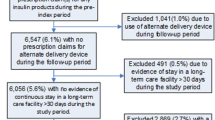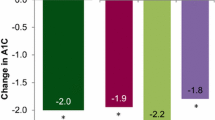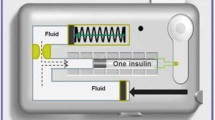Abstract
Introduction
Diabetes is difficult to manage and treatment involves significant lifestyle adjustments. Unlike the traditional method of insulin administration via the vial and syringe method, insulin pens might be perceived as less cumbersome and have potential to significantly increase patient adherence.
Methods
Using “real world” data, we examined the differences in adherence and costs between diabetic patients using an insulin FlexPen® (Novo Nordisk Inc, Princeton, NJ, USA) and those using traditional vial and syringe administration. Using a retrospective analysis of health insurance claims data between the years 2003 and 2008, we examined patients in the FlexPen cohort and analog vial cohort. Propensity score matching was used to match these cohorts (n=532 in each) according to baseline characteristics.
Results
Adjusted mean medication possession ratio when switched to FlexPen improved by 22 percentage points versus 13 percentage points when continuing to use vials (P=0.001). Diabetes-related healthcare costs when switched to FlexPen versus continuing on to use vials ($3970 vs. $4838, respectively, P=0.9368) and total healthcare costs ($13,214 vs. $13,212, respectively, P=0.9473) were not statistically different.
Conclusion
Without significant addition to the cost, insulin administration with FlexPen is associated with an improved adherence among patients who switched from vial-based insulin administration.
Similar content being viewed by others
References
Gonder-Frederick L, Cox D, Ritterband L. Diabetes and behavioral medicine: the second decade. J Consult Clin Psychol. 2002;70:611–625.
Clarke P, Gray A, Briggs A, et al. A model to estimate the lifetime health outcomes of patients with type 2 diabetes: the United Kingdom Prospective Diabetes Study (UKPDS) Outcomes Model (UKPDS no. 68). Diabetologia. 2004;47:1747–1759.
American Diabetes Association. Economic costs of diabetes in the U.S. in 2007. Diabetes Care. 2008;31:596–615.
Wild S, Roglic G, Green A, Sicree R, King H. Global prevalence of diabetes estimates for the year 2000 and projections for 2030. Diabetes Care. 2004;27:1047–1053.
Burge M, Gamache L, Pai H, Segal A. Hypoglycemia and self-care in elderly patients with diabetes mellitus. In: Munshi MN, Lipsitz LA, eds. Geriatric Diabetes. New York, USA: Informa Healthcare; 2007:331–356.
Burkhart P, Dunbar-Jacob J. Adherence research in the pediatric and adolescent populations: a decade in review. In: Hayman LL, Mahon MM, Turner JR. Chronic Illness in Children: An Evidence-based Approach. New York, USA: Springer; 2002:199–229.
Hirsch I. Insulin analogues. N Engl J Med. 2005;352:174–183.
Oiknine R, Bernbaum M, Mooradian A. A critical appraisal of the role of insulin analogues in the management of diabetes mellitus. Drugs. 2005;65:325.
Molife C, Lee L, Shi L, Sawhney M, Lenox S. Assessment of patient-reported outcomes of insulin pen devices versus conventional vial and syringe. Diabetes Technol Ther. 2009;11:529–538.
Lee W, Balu S, Cobden D, Joshi A, Pashos C. Medication adherence and the associated health-economic impact among patients with type 2 diabetes mellitus converting to insulin pen therapy: an analysis of third-party managed care claims data. Clin Ther. 2006;28:1712–1725.
Baser O. Too much ado about propensity score models? Comparing methods of propensity score matching. Value Health. 2006;9:377–385.
Stukel TA, Fisher ES, Wennberg DE, Alter DA, Gottlieb DJ, Vermeulen MJ. Analysis of observational studies in the presence of treatment selection bias: effects of invasive cardiac management on AMI survival using propensity score and instrumental variable methods. J Am Med Assoc. 2007;297:278.
Osterberg L, Blaschke T. Adherence to medication. N Engl J Med. 2005;353:487–497.
Brixner D, McAdam-Marx C. Cost-effectiveness of insulin analogs. Am J Manag Care. 2008;14:766–775.
Brunton S. Safety and effectiveness of modern insulin therapy. Current issues in the management of type 2 diabetes. ConsultantLive, July 2009. Available at: imaging.ubmmedica.com/consultantlive/supplements/0907Con_DiabetesSup_HR.pdf. Accessed: March 8, 2010.
Pawaskar MD, Camacho FT, Anderson RT, Cobden D, Joshi AV, Balkrishnan R. Healthcare costs and medication adherence associated with initiation of insulin pen therapy in Medicaid-enrolled patients with type 2 diabetes: a retrospective database analysis. Clin Ther. 2007;29:1294–1305.
Author information
Authors and Affiliations
Corresponding author
Rights and permissions
About this article
Cite this article
Baser, O., Bouchard, J., DeLuzio, T. et al. Assessment of adherence and healthcare costs of insulin device (FlexPen®) versus conventional vial/syringe. Adv Therapy 27, 94–104 (2010). https://doi.org/10.1007/s12325-010-0009-6
Received:
Published:
Issue Date:
DOI: https://doi.org/10.1007/s12325-010-0009-6




